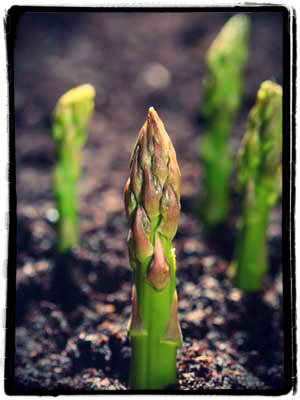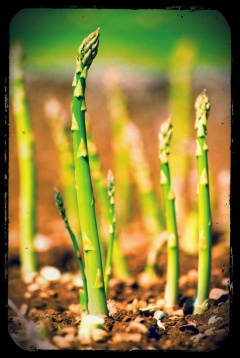Asparagus: Nutrient Filled?Vegetable
Do you love asparagus? As much as you love asparagus in you salad, you would love it even more if you grow them in your garden. The word asparagus originates from the Greek language meaning ?sprout? or ?shoot?. Asparagus is a member of the lily family, same family where onions and garlic is under ?Allium. It was believed to be cultivated thousands of years and originated in Mediterranean?coasts. So, let?s find out more about asparagus below.
General Facts:
Scientific Name: Asparagus officinalis (Liliaceae family)

growing asparagus
Common name: Asparagus, sparrow grass
Common Varieties:
- White asparagus (70% of asparagus production), which is grown without light or air (?earthed-up?).
- Green asparagus (10%), grown in the open air.
Plant Types: Perennial, Vegetable
Light: Partial Shade to Full Sun
Leaf Color: Green
Special Features: Attractive foliage, Deer resistant, Edible
Propagation: Seed, division
Plant Care:
- Grow in well-drained and moist sandy soil with neutral pH. In planting asparagus, it must have a 9 to 12 apart spacing.
- Asparagus is salt tolerant and can withstand dry periods but watering it weekly must be done during harvest period.
- Asparagus is medium-heavy feeder. It consumes potassium in high amount and requires nitrogen so you must consider this when fertilizing.
- Harvest asparagus in the second year of planting.This allows the plant grow strong and not spindly. Harvest the spears when they are about 1/2 inch in diameter. It is best?to harvest?them in he morning.
- Pest: Fusarium root rot, rust disease, asparagus beetles.


Nutrition:
- Rich in Vitamin K, folate, C, A, tryptophan, B1, B2
- It is also a good source of glutathione, the master antioxidant and a regenerator of immune cells.
- Asparagus has No Fat, contains No Cholesterol and is low in Sodium.
- Asparagus contains substances that act as a diuretic, neutralizes ammonia, protects small blood vessels and also works as a laxative.
Interesting Facts:
- There is a recipe for asparagus in the oldest surviving cookbooks that dates back to the third century AD.

asparagus salad
- Romans and Greeks alike ate asparagus for the rich flavor and medicinal qualities.
- The fruit from Asparagus is a small red berry that is poisonous to humans.
- Asparagus came to America with the early colonists. Cultivation spread west to include New Jersey, Michigan, California and Washington State.
- Asparagus is best planted near tomatoes as each plant repels bugs that bother the other.
- China is the leading producer of asparagus, following by Peru, Germany, Mexico, USA, Italy and Spain.
This vegetable is indeed a wonder, a nutrient filled plant that you will certainly love to have in your vegetable garden. So what are you waiting for? Grow some and reap the benefits of asparagus in the future!
References:
Asparagus ( Better Homes And Gardens)
Vegetable Profiles: Asparagus ( Grow It Eat It)
Plant Library: Asparagus (Easy Bloom)
Like this:
Loading...
Posted in Gardening, Health, Vegetable Library and tagged asparagus, Asparagus officinalis, food, garden, gardening, glutathione, growing asparagus, planting asparagus, sparrow grass, VegetableSource: http://nelsontheadventurer.wordpress.com/2013/03/14/asparagus-nutrient-filled-vegetable/
kansas ohio state wrestlemania results womens final four josh hutcherson google april fools office space shell houston open
No comments:
Post a Comment
Note: Only a member of this blog may post a comment.